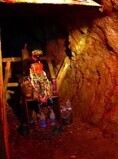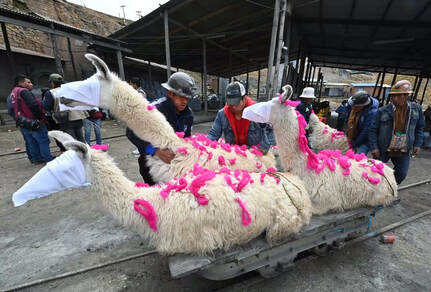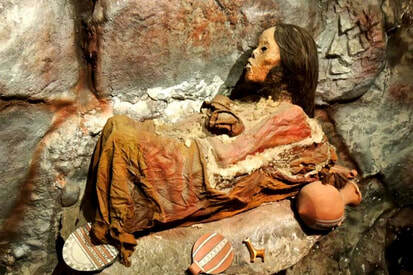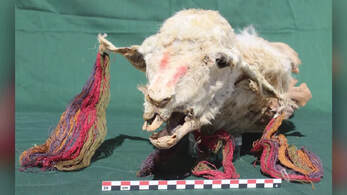The Devil You Know
 By M.P. Pellicer | Stranger Than Fiction Stories
By M.P. Pellicer | Stranger Than Fiction StoriesHis face is chalky, with eyes as dark as his mustache. The mouth is open below nostrils blackened from cigarette smoke, and you call him Uncle.
 Tio devil depicted in a mine in Potosi, Peru According to this tradition, hundreds of these devils are found throughout mines in South America.
Tio devil depicted in a mine in Potosi, Peru According to this tradition, hundreds of these devils are found throughout mines in South America.He is covered with varied adornments, sitting on a throne with hands extended to receive his due. The feet are shod in rubber mining boots. Hard to miss is his erect penis to remind those who come before him of his virility. This devil's kingdom is Bolivia's tin mines, even though no miner will refer to him as supay which is the Quechua word for devil. Instead the more familial tio, Spanish for uncle is used.
Tio protects miners from accidents as they work in the deep, black holes, but he can also bring harm. Part of his allure is that he can bring prosperity in the quest for veins of tin and silver. In order to placate Tio to both avert disaster or for his generosity homage is paid him through Pachamama.
What he is given depends on the day of the week. Coca leaves, hand-rolled cigarettes on Tuesday and Friday, accompanied by white rum to quench his thirst.
 Sacrificial llamas meant to appease the devil El Tio by Bolivian miners (Source - Aizar Raldes AFP) The miners perform cha'alla each carnival Tuesday, pouring the earth around his image with chicha which is rum or beer. He is surrounded by food, and confetti garlands are draped around his neck.
Sacrificial llamas meant to appease the devil El Tio by Bolivian miners (Source - Aizar Raldes AFP) The miners perform cha'alla each carnival Tuesday, pouring the earth around his image with chicha which is rum or beer. He is surrounded by food, and confetti garlands are draped around his neck.On day before August 1 comes the toast of K'araku, where a llama is sacrificed. The animal's blood is poured on the threshold of the mine, and the rest is splattered on the walls. Some miners smear their faces with the blood as well, taken from the still-beating heart of the animals. This is considered good luck.
This ritual is performed by yatari or indigenous witch doctors once a year in February or March, on the eve of the street parade of the Oruro carnival. It is one of Bolivia's biggest festivals, and is listed by UNESCO as an "intangible cultural heritage."
The llama's heart once removed is placed at the statue's feet. After this everyone must leave the mine so El Tio can enjoy his meal, since the blood and hearts of the animal are his favorite meal.
Another blood sacrifice known as wilancha is performed differently. The miners "take a live llama and place it in a mining cart with offerings impregnated with alcohol and kerosene," lighting it as it enters the depths of the mine. The animal is incinerated alive, and afterwards consumed by the participants. What is left is buried as part of the "payment" to Tio and his mine. The offerings are supposedly meant to repay the earth for the minerals taken by the miners.
Carnival time is when El Tio Diablo leaves the mines, disguised as Lucifer where he dances with other demons.
Women are strictly forbidden from entering a mines or participating in ceremonies, as there is a fear the veins of minerals will disappear.
Even women who have lost their husbands in mining accidents, and known as palliris must work outside the mines when they scavenge anything.
The Tio Devil is found throughout the mining districts of the central Andes. The muqui, similar to the the Tio is found in Peru's Ticlio, Morococha, Cerro de Pasco and other mines. The muqui must also be appeased in order to receive his protection.
Despite the offerings made to the Devil Uncle and other similar demons, in the Cerro Rico mountain in Potosi, 8 million men have died there since the mid-1500s. The belief is that if El Tio is not fed, he will feed on human flesh, so it appears he is a hungry devil.
Statues of a Tio are found throughout the mines, where miners go and sit with the idols to keep him company, since he doesn't like to be left alone.
Despite the miners identifying as Catholic, most of them believe that God cannot be found in the depth of the mines. Only El Tio can protect them as they scramble down narrow passages into the bowels of the earth.
 The Juanita Mummy AKA The Lady of Ampato The sacrifices made to El Tio recall the earlier religious ceremonies from the Inca Empire prior to the arrival of Europeans, known as capacocha.
The Juanita Mummy AKA The Lady of Ampato The sacrifices made to El Tio recall the earlier religious ceremonies from the Inca Empire prior to the arrival of Europeans, known as capacocha.In the 1990s, remains of sacrificed children victims were found on the Ampato and Pichu Pichu volcanoes in southern Peru.
Three bodies were found at Ampato at 19,000 feet. The Pichu Pichu capacoha were on a constructed platform at 18,000 feet.
Capacochas were done to bless shrines, in response to catastrophes and to celebrate major construction activities especially if it involved irrigation. The rituals were also performed annually at the Temple of the Sun in Cusco.
 Individual with elongated skull found at Pichu Pichu The victims were young virginal women or children who had no imperfections. However there has been evidence that children sacrificed suffered from serious diseases.
Individual with elongated skull found at Pichu Pichu The victims were young virginal women or children who had no imperfections. However there has been evidence that children sacrificed suffered from serious diseases. In an expedition that lasted from 1995 to 1999, a total of 20 persons were found ranging in age from 3 to 15 years of age. The method described for the sacrifice of the children was by a blow to the head, buried while alive, removal of the heart or strangulation.
One of the remains found at Pichu Pichu displayed cranial modification in an oblique manner done since infancy which caused elongation.
Mass sacrifice of children predate the Incas. In Chimu in northern Peru, 137 children, aged 5 to 14 years were burned alive sometime between 1400 to 1450 AD. There was evidence some had their hearts removed.
The deity Pichu Pichu is a diety that shepherds make offering to in order to gain his protection for themselves, and their herds.
Other studies point out that some of the ritual massacres in the Andes range back to pre-Inca times, but their numbers and sophistication increased with the expansion of the empire from its capital Cusco. These studies indicate that Capacocha (sacrifices of children) was used as a means of social control. According to these, the tombs acted as warnings designed to instill fear in the conquered peoples.
 The sacrificed animals were adorned with colored string earrings and necklaces. (Source - L.M. Valdez) In 2018, four llama mummies were discovered under the floor of a building. They were ritually sacrificed at the beginning of the 15th century. The site is known as Tambo Viejo. Three white llamas were killed to appease the sun god, and one brown llama to the creator god. Several dozen guinea pigs were killed as well.
The sacrificed animals were adorned with colored string earrings and necklaces. (Source - L.M. Valdez) In 2018, four llama mummies were discovered under the floor of a building. They were ritually sacrificed at the beginning of the 15th century. The site is known as Tambo Viejo. Three white llamas were killed to appease the sun god, and one brown llama to the creator god. Several dozen guinea pigs were killed as well.For the Incas, llamas were only second to human beings in their value as sacrificial offerings. Radio carbon dating of the four animals date the remains to between 1432 to 1459. They were not cut or stabbed so researchers believe they were buried alive, as was done to humans who were sacrificed.
Intact discoveries like this one confirm accounts of early Spaniards in South America which described that the Inca sacrificed animals by the hundreds. MAN CLAIMS HE WAS OFFERED AS A SACRIFICE AT PACHAMAMA FESTIVAL IN BOLIVIA
Published on November 01, 2022 08:00
No comments have been added yet.



